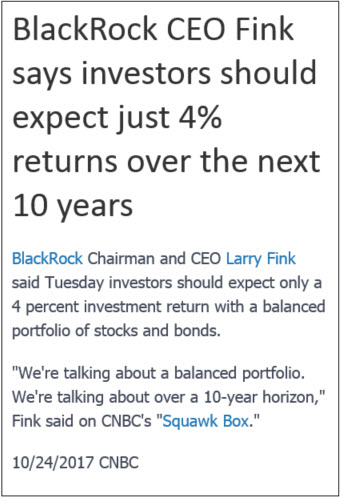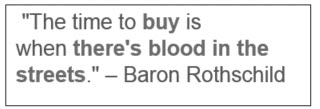
I am often asked by people interviewing my company how to be successful at investing. Most think the driving force is cost; whether it be using the lowest cost mutual funds, indexes, etc. or doing it yourself so as to avoid advisor related fees altogether. Contrary to popular belief, I believe cost is not among the 2 most critical things you need most to be successful. I also think that in order to realize your portfolio’s maximum potential, you need the following:
- A Certified Portfolio Manager (CPM)
- To be a confident client
What is a Certified Portfolio Manager?
There are approximately 300,000 investment advisors in the country, many with acronyms following their name on the card. There are many certifications behind those names; at least 15, give or take a few. To the untrained eye, knowing which one you need your advisor to have can seem a bit daunting.
Rather than list all the certifications and confuse the issue, let’s focus on what I believe to be the two most important certifications; CPM (Certified Portfolio Manager) and CIMA (Certified Investment Management Analyst). Both certifications not only require a minimum of at least 3 years of professional experience to pursue these certifications, which demonstrate an in depth understanding of concepts and technical expertise, but also require designees to consistently complete at least 40 hours of continuing education every two years. Those training programs are the CPM (Certified Portfolio Manager) and the CIMA (Certified Investment Management Analyst). Each of these certifications require over 200 hours of study over the course of a year followed by a final exam at the conclusion of a week of class.
A very common certification is the Certified Financial Planner or CFP®. However, that program spends only a fraction of the time on portfolio management and more time on financial goal planning related to your income, expenses, savings rates, social security and estate planning. A CFP is good at telling you if you have enough money to reach your goal or how much more you need to save to get there. All important issues I grant you, but those are mathematical equations based on an assumed rate of return of on your portfolio.
Unlike the focus of a Certified Financial Planner, a Certified Portfolio Manager is expert at determining how not only to generate return, net after fees, but to maximize that return as well as minimize losses during volatile market swings.
Flawed Assumptions
Accurate assumptions are more critical than ever when calculating your financial plan because what used to be tried and true has changed. What some may consider a typical “conservative” strategy assumes that if you put half of your money in bonds paying 5% and half of your money in stocks making 9%, then the blend of the two investments should yield 7%. However, that is inaccurate for the following reasons:
- Bonds no longer pay 5% and have not for 10 years
- Stock returns depend on when you buy them
- Fees reduce your returns
Today, investing is a bit more of a Rubik’s cube puzzle. How do you generate 7% net after fees without taking huge risks? To do so, your advisor must be willing to go above and beyond the norm in terms of research, evaluation and strategy development for purchasing and selling investments. Gone are the days of buy and hold forever. In addition, you must be confident in your advisor’s analysis and methodology to follow recommendations. Most advisors have not been trained in portfolio management because it requires extensive commitment from both parties to get certified and that advisors be allowed the flexibility to practice and execute strategies that are innovative and often fall outside the corporate box of traditional thinking.
Some large firms want their advisors to put their client’s money into an “approved firm model” and go find the next client. The problem is that some firms have not updated their investment model assumptions in over 30 years to account for the current low

interest rate environment. For instance, J.P. Morgan Asset Management publishes their “Long-term capital market return assumptions”1 annually and as of 2015, their assumed return on bonds was 5% and cash was 2%. Bonds and cash have not yielded 5% and 2% respectively in quite some time, and most likely will not for the next decade. If you use these assumptions for a moderate portfolio, I believe it’s unlikely you will achieve returns that will allow for a 4% withdrawal rate and have your money grow enough to keep up with inflation. In fact, just recently on October 24, 2017, Larry Fink, CEO of asset manager BlackRock, agreed when he said “investors should expect only a 4 percent investment return with a balanced portfolio of stocks and bonds.”
Not making the returns you assume could cause you to outlive your financial resources. A Certified Portfolio Manager (CPM®) is trained to immediately appreciate faulty assumptions and make adjustments to better position you to hit your target returns.
A Confident Client
Confidence comes from knowledge and experience. I believe that if you have a skilled manager and you are confident in their skills, you are less likely to be scared during the inevitable market swings and occasional downturns. As an example, DALBAR, an investment performance and behavior consulting company, publishes an annual study that shows a significant performance gap between “the market” and investors. Over the last 20 years, through December 31, 2015, the S&P 500 index has earned a compound return of over 8% but the average investor has made only 4%.* The difference is caused by investors selling stocks in a down market. Investors feel despondent in downturns and sell prematurely or buy stocks at the height of the market when they feel confident.

We have all heard that you should buy low and sell high, but that’s easier said than done. People are highly emotional about money – especially about losing it. It takes a great deal of confidence to buy stocks when they are down, and the headlines on TV are negative about the market.
Confidence comes from knowledge, too. If you understand that market corrections occur about twice each year and anticipate them, you can take advantage by buying when prices are low while other investors are panicking or paralyzed.
Knowledge about how your investment manager makes decisions can also help you during times of market turbulence. If you are familiar with your advisor’s process and understand how they make investment decisions, I believe you will have more confidence when stock prices become volatile.
Your confidence is a powerful tool for your advisor as well. The calmer you are during market declines, the less likely your advisor is to be influenced by your fear. Fear is contagious and can result in poor decisions at exactly the wrong time potentially hobbling your investment returns.
The Bottom Line
Choose your advisor wisely – use a Certified Portfolio Manager who has both a passion for their work and has weathered several market cycles, at least 15 to 20 years of experience.
* Source: “Quantitative Analysis of Investor Behavior,” DALBAR, Inc., March 2017. This study was conducted by an independent third party, DALBAR, Inc. A research firm specializing in financial services, DALBAR is not associated with U.S. Asset Management or Advisory Services Network. The information herein is believed to be reliable, but accuracy and completeness cannot be guaranteed. It is for informational purposes only and is not a solicitation to buy or sell securities.
1. https://am.jpmorgan.com/blobcontent/1413613727995/83456/LTCMA_Assumptions_White_Paper_2015_US.pdf

David.Cross@us-am.com

